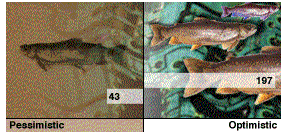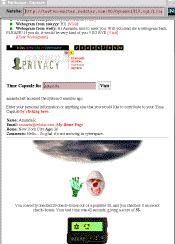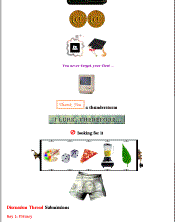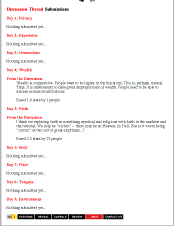The event was structured as a ten day countdown, in order to build interest and word of mouth referrals. The countdown gave people a chance to see the site, participate in it and to link to it. Each day had a different theme. The site was cumulative: the first days theme was ``Privacy'' and that was the only material available. The second day was ``Expression'' and one could visit both the new area and the Privacy area. The site thus grew every day and people were encouraged to return daily to see what was new. The tenth day was a summary of the previous days, including survey results, live feeds from the Lab, and the opening of the Portraits in Cyberspace exhibit.
The nine countdown days all shared a common structure. There was a daily discussion (``Expound''), a survey (``Reveal''), and a short summary piece filled with links to the rest of the Web (``Review''). In addition, one could wander among the internal home-pages (called ``Capsules'') of the other people on the site.
7.1.1 Expound: rated discussion
Each Expound section began with a short essay about the day's topic followed by the discussion section. Here you would see a set of three user comments on the topic. Each one could be rated on a scale of 1 (``low quality or unoriginal'') to 5 (``a real gem''). Next to each comment was its current rating and how many people had rated it so far. You could rate the visible comments or press a button to see a new set. The algorithm for selecting comments to show gave precedence to highly rated comments and to new ones with few ratings. The low-rated ones would slowly disappear - but not so quickly that a couple of early negatives would consign a remark to oblivion.The author's name accompanied each comment and was a link to his or her capsule page. Any comments one had contributed showed up on this page - the process of taking part in the discussions thus was part of what created one's own portrait in this site. At the bottom of the Expound page was a form for contributing your own remarks (with the fact that this contribution would be part of your capsule page prominently noted).
We decided to experiment with a rated discussion model instead of the usual threaded discussion for several reasons. One of our goals was to gather people's opinions and reactions as part of a ``Portrait of the Net, 1995''. Thus, we wanted the comments to be stand-alone remarks, whereas letters in a threaded discussion are often too heavily interwoven with the ongoing conversation to stand on their own. Similarly, for the comments to be included in the capsule pages they needed to be readable as independent remarks. Furthermore, we wanted to encourage people to write something outstanding (or coherent, at least). Too often, threaded discussions and on-line chats veer off-topic or devolve into nonsense and name-calling. The rated discussion seems to have succeeded in getting people to try to write something that others would rate highly - compared to many Usenet letters, and certainly to on-line chats, the statements in the Expound section are lucid, well-written, and often thought provoking.
7.1.2 Reveal: surveys and visualizations
The Reveal section consisted of a series of mini-surveys, each linked to the day's topic. They were designed to be short, simple and entertaining: an easy way to participate in the site. Most of them were multiple choice questions, where you checked applicable answers. On ``Expression'' day, for instance, we asked people what activities they participated in on the Net - build home pages, chat, access databases, send email, etc. On ``Faith'' day we asked about adherence to various belief systems, both religious and nontraditional. Part of the ``Place'' day survey asked participants to point out where you are on a map of the world. On ``Body'' day, we included a ``physical fitness'' test - a mouse-clicking race.One's answers to the survey, like the contributions to the discussions, showed up on one's capsule page, but in an abstracted, graphical form. The idea was to provide some feedback without generating misleading pseudo-scientific results. The graphic also served to decorate the capsule pages - to make those of the active participants colorful and compelling.

|
The results of the Environment
survey.
Clicking on any region of this
image brings you to the capsule of
someone whose views were in that
part of the pessimism-optimism
range.
For example, clicking where the
label a is brought up the capsule of
rmarks, from Michigan. On
environment, he said
While more people seem to be more aware of envi ronmental issues and prob lems, few seem willing to make lifestyle changes that would really make any difference. The power is still in the hands of corpo rate America and if care for the environment is not put ting cash in their pockets, then it is not their top prior ity.Clicking on spot b brought up typhoto. His comment was: Any technological advancement that makes this world a little smaller and brings people from all corners of the globe together in the same place is a great step towards peace among nations." From his capsule, one could go to his home page - which revels in the wonders of enhanced Netscape features and VRML. |
These visualizations were more simplistic than we liked, due both to the limitations of the Web and the small amount of data that could be gathered in the course of such an event. An interactive visualization, like Visual Who, with which the users could explore the community space would have been preferred, but was not possible within the existing Web environment. Perhaps the most missed feature was the ability to find a particular user in the data: you could click on a dot and find out who it was, but you could not request that a specific person be highlighted.
7.1.3 Capsules & web-o-grams: persona & presence>
Wandering the web is usually a solitary experience - one has little sense of the presence of others. The 1010 site had a number of features that made visiting it a far more sociable experience.
You entered the site by signing in - your real name was not required, but you needed to provide an identifying name and password. A home page, called your ``Capsule'', was created for each participant. If you chose to, you could include your real name, email address, home page, or other text and pictures in this capsule. And, as described above, your contributions to the discussion and your answers to the surveys were also recorded in the capsule. Ordinary home pages are designed once and then updated infrequently. These capsule pages had the interesting characteristic that they were updated continuously through your participation in the site - they are not the wholly self-conscious creations that home-pages usually are.


